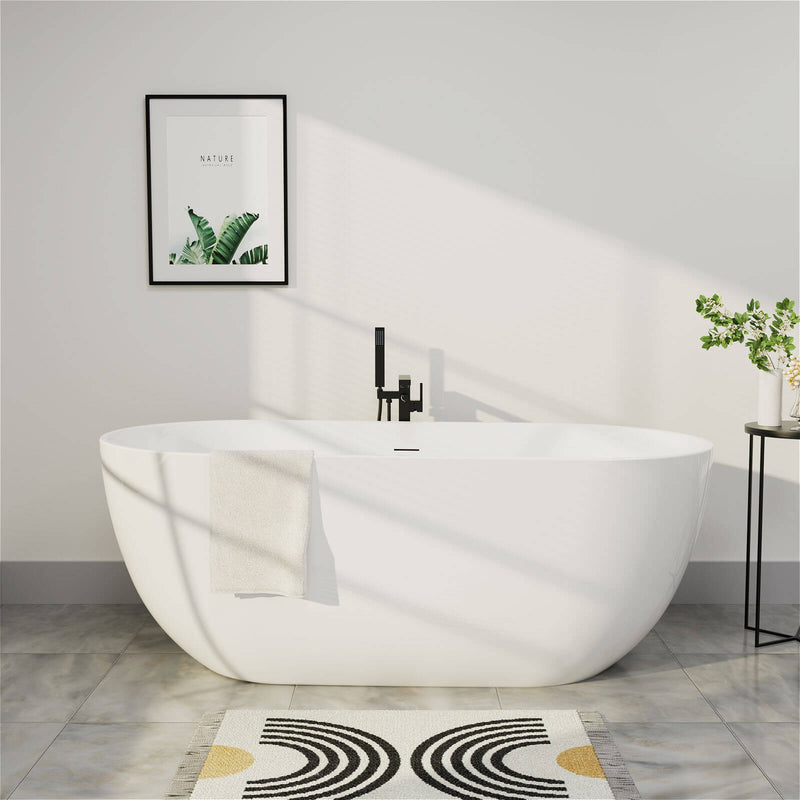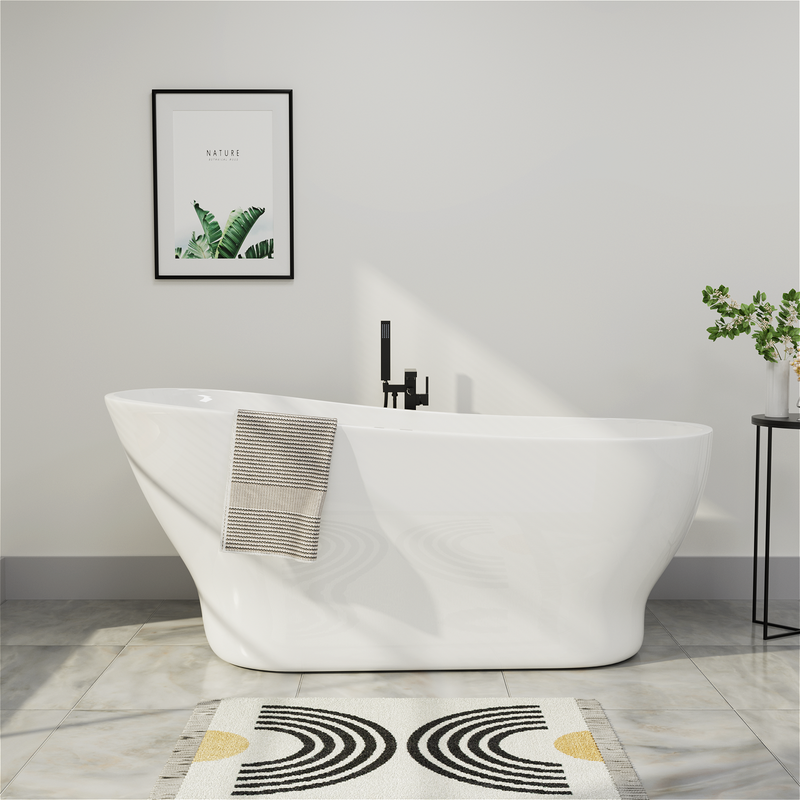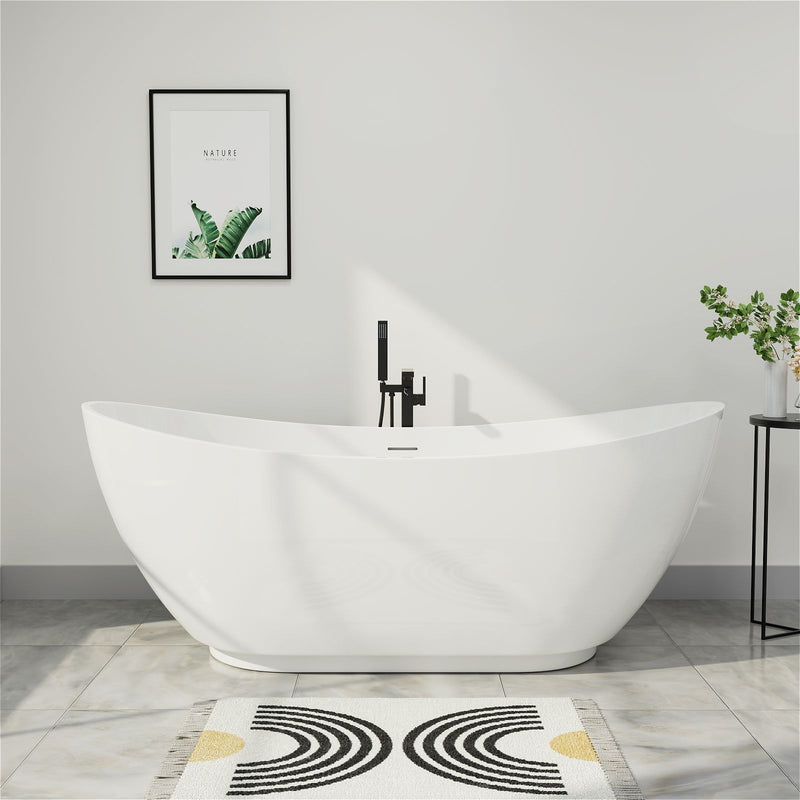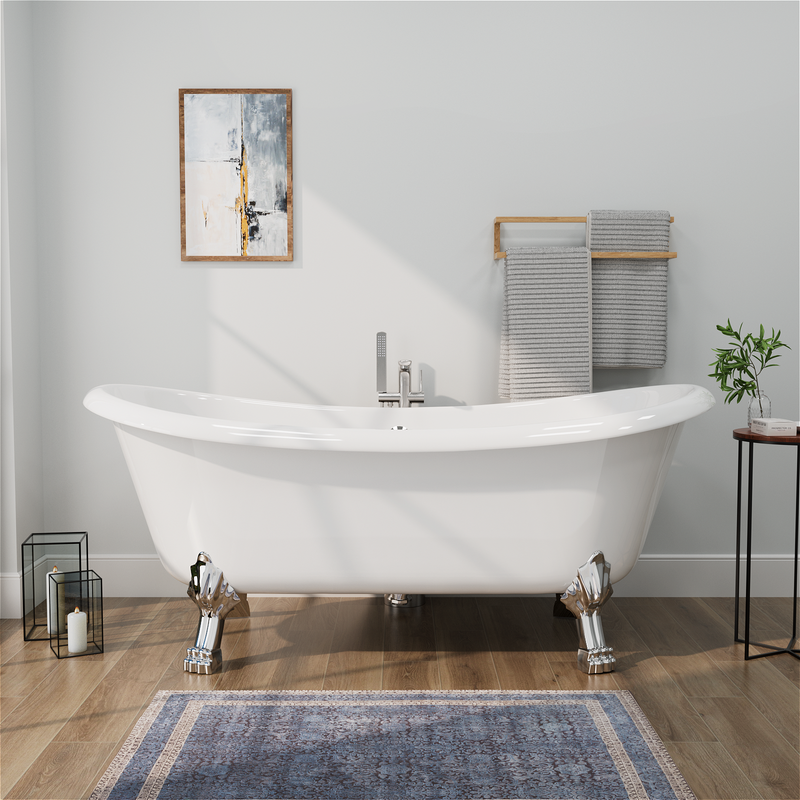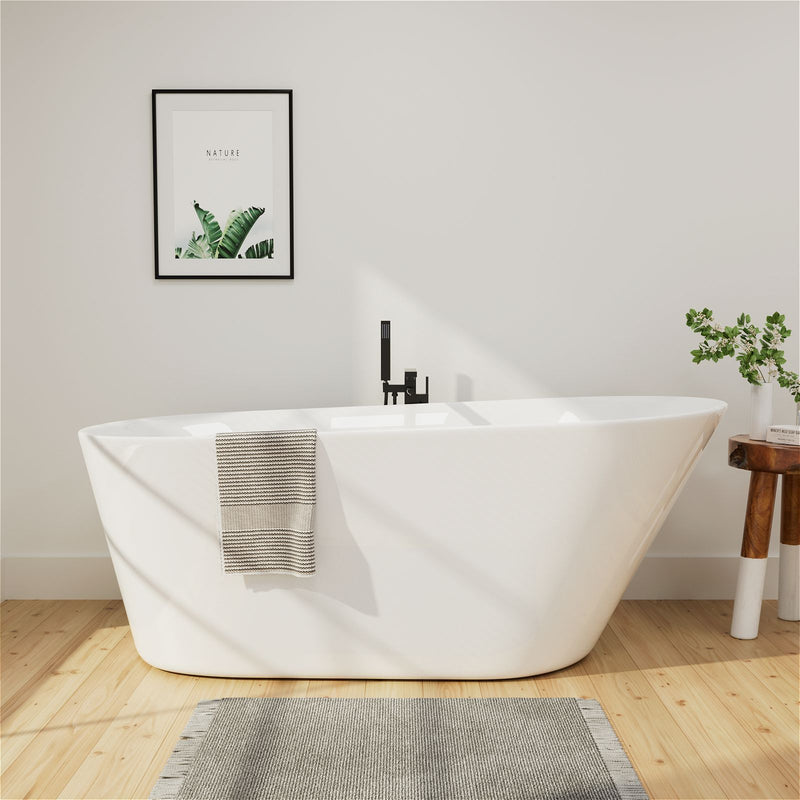When a carefully selected bathtub elegantly sits in the center of the bathroom or cleverly recessed into the wall, people often assume the star of the bathroom space has been decided. However, it's often the seemingly insignificant supporting elements - the bathtub hardware - that truly give the bathtub its soul, determining the user experience and aesthetic appeal. The faucet, showerhead, grab rails, soap dish, and even the small overflow cover - they're like the bathtub's jewelry and joints. Beyond their functionality, they silently convey the style of the space and the owner's taste.
With the wrong hardware, even the most expensive bathtub can appear awkward or cheap. A poorly flowing faucet can disrupt the tranquility of a bath, and a clash of styles can instantly throw a carefully designed space off balance. How can these supporting elements perfectly complement the bathtub itself and resonate harmoniously with the entire bathroom environment? This isn't just a matter of selecting technical specifications; it's also an art form that balances function and aesthetics. This article will delve into the art of matching bathtub hardware to help you create a bathing space that's both comfortable, practical, and aesthetically pleasing.
Core Foundations: Understanding Bathtub Faucet Faucets and Key Tips for Choosing Them
The faucet is the master switch controlling water flow and the hardware component that interacts most frequently with the bathtub. When choosing a bathtub faucet, consider installation method, functional requirements, and visual style.
Three Main Installation Types of Bathtub Faucets
Wall-Mounted Faucets
Features: The plumbing and valve are completely concealed within the wall, with only the control handle and spout (swanneck or straight) mounted on the wall behind the bathtub. This offers the most streamlined and modern visual experience.
Applicable: Most commonly found in built-in bathtubs (especially acrylic or cast iron bathtubs mounted against the wall). Precise pre-installation of the plumbing and valve cartridge base is required during the plumbing and electrical renovation phase, making later modifications difficult.
Advantages: It saves space around the bathtub rim, making it easy to clean the wall and bathtub rim, and offers a simple and elegant style.
Disadvantages: Complex installation, high pre-installation precision is required, and valve cartridge repair requires removing wall tiles (selecting a high-quality valve cartridge and pre-installed box is crucial).
Deck/Rim-Mounted Faucets
Features: The entire faucet is mounted to the bathtub rim (desktop) or directly into the pre-installed holes in the bathtub. This is the most traditional and common installation method.
Application: Widely suitable for freestanding bathtubs (especially claw-foot bathtubs, those requiring water supply from the side or rim) and most built-in bathtubs (thumbnail-mounted bathtubs).
Advantages: Relatively flexible installation (especially for freestanding bathtubs), a wide selection of styles, and easy maintenance and replacement.
Disadvantages: It takes up space around the bathtub rim, requiring careful positioning around the faucet base when cleaning the rim, which can be visually complex.
Floor-Mounted Faucets
Features: A separate column or bracket structure that extends upward from the floor. The faucet body is mounted on this bracket, with the spout extending over the bathtub rim and into the tub. It usually has its own or requires an underground water supply connection.
Application: Primarily designed for freestanding bathtubs (especially those placed in the center of a room without surrounding walls), creating a strong sense of design and luxury.
Advantages: It offers a strong visual impact, a strong sense of art and spaciousness, and solves the water supply problem of central freestanding bathtubs.
Disadvantages: It is generally more expensive, takes up floor space, requires precise location planning (especially for floor plumbing), and can be difficult to clean around the bathtub floor.
Functional Requirements: More Than Just Hot and Cold
Single-Handle vs. Dual-Handle
Single-Handle: Most common. A single handle controls both the hot and cold water levels (typically left and right for temperature adjustment, and up and down for flow/water volume). It's convenient and intuitive, especially suitable for slippery hands, and offers a modern aesthetic.
Dual-Handle: Two independent handles control hot and cold water, respectively. This offers a more retro or classic feel, and precise temperature control may be more intuitive (although it requires two hands). It also ensures water flow in extreme situations (such as a handle malfunction).
Thermostatic Function
Core Value: Automatically mixes hot and cold water using a built-in thermal element, maintaining a constant outlet temperature at a preset value (e.g., 38°C). This effectively prevents sudden temperature fluctuations caused by external water pressure fluctuations or other users using the water during bathing, a crucial safety feature for the elderly and children.
Identification: Thermostatic faucets typically have a clear temperature indicator or a safety button (to prevent accidental high-temperature water).
Diverter Valve
Purpose: Controls the direction of water flow. Commonly found in bathtub faucet combinations with shower heads. Direct the water flow from the bathtub spout to the hand shower or overhead showerhead using a pull-to-switch, a button, or a side-switch.
Importance: Smooth switching and a good seal (preventing simultaneous water flow and leaks) directly impact the user experience.
Spout Style: Elegance and Practicality
Swanneck Spout
Classic Choice: The elegant curved pipe design extends high above the bathtub rim, creating a high water outlet point. The water falls into the tub in a parabolic arc, minimizing splash and creating a visually elegant and refined look.
Suitable for: Suitable for a wide range of styles, especially complementing freestanding bathtubs, classic, and retro styles. Ensure sufficient height to avoid head bumps.
Straight/Short Spout
Modern and Simple: The spout features a straight forward or slightly downward angled design, with a simple structure and clean lines.
Suitable for: Modern and minimalist styles, often used in built-in bathtubs. Note that the water drop point is close to the bathtub rim, which may cause slight splashing.
Waterfall Spout
Sensory Experience: The spout is wide and flat, and the water cascades down in a sheet-like pattern, creating a unique visual effect with a gentle impact and pleasant sound.
Applications: Create a spa-like atmosphere, suitable for modern, natural, and resort styles. However, the water flow is slow, so it takes a long time to fill the tank.
Material and Finish: Durability and Aesthetics Guaranteed
Main Materials
Brass: The industry-standard base material. Strong, durable, and corrosion-resistant, it is easily processed into various shapes and can be treated with a variety of surface finishes. The internal valve core is also often made of brass or ceramic. (Key Point: Pay attention to whether the main body is all copper.)
Stainless Steel: Strong corrosion resistance, high strength, and a strong modern look. However, styling options are relatively limited, and processing costs are high.
Zinc Alloy: Lower cost, commonly used in mid- and low-end products. Generally, its strength, corrosion resistance, and durability are inferior to brass.
Common Finishes
Chrome Plating: The most classic and common. It offers a bright finish, strong reflectivity, good wear resistance, easy cleaning, and a relatively affordable price. Suitable for almost any style (especially modern and minimalist).
Brushed Nickel/Satin Nickel: A matte or softly glossy finish with a delicate, silky texture. It offers a warm, luxurious feel, is resistant to wear and fingerprints, and doesn't show limescale easily. It's suitable for modern, affordable luxury, and industrial styles.
Matte Black: Extremely popular in recent years. It offers a strong modern and dramatic effect, creating a cool or calm atmosphere. Be sure to choose a high-quality coating (scratch-resistant and water-stain-resistant).
Antique Bronze/Bronze: Offers a vintage, aged effect with a sense of time. Suitable for classic, rustic, industrial vintage, and Mediterranean styles. Careful maintenance is required (some finishes may oxidize and discolor over time).
Gold (PVD Gold/Rose Gold): Represents a luxurious, warm, and affordable luxury style. When choosing, pay attention to the color tone (yellowish gold, pinkish rose gold) and the quality of the coating (fading resistance).
Key selection tips: Prioritize a faucet with an all-copper body, a high-quality valve core (such as a ceramic valve core), and a thick electroplating finish that meets national/international standards (e.g., salt spray test grade 10 or higher). This directly determines the faucet's lifespan, environmental friendliness (lead-free or low-lead copper), and long-term aesthetics.
The Rhythm of Water: The Art of Matching Shower Systems
The shower system is key to shaping water flow into a comfortable experience, especially when the bathtub also functions as a shower.
Shower Type: Suitable for Various Bathing Scenarios
Handheld Shower
Must-Have: Versatile and versatile. Can be used for showering, rinsing bathtub walls, bathing pets, assisting with shampooing, and more.
Choice Considerations
Weight and Grip: Lightweight and comfortable for prolonged holding.
Hose Length and Flexibility: A sufficiently long (1.5-2 meters), tangle-resistant, and durable stainless steel braided hose.
Multi-Function Showerhead: Multiple spray modes (such as rain, massage, mist, and combination) meet diverse needs.
Mount: Adjustable, stable, and easily locked bracket (wall-mounted or pole-mounted).
Overhead Showerhead
Immersive Experience: Wide coverage, simulating the effect of natural rain, for an invigorating bathing experience.
Key Considerations
Size: Choose based on the width of the tub/shower area and personal preference (8-12 inches is common). A larger size can be oppressive in a small space, while a smaller size provides insufficient coverage.
Installation Height: Typically about 2 meters above the ground, but consider the height of family members and the ceiling height (to avoid head-on collisions).
Water Spout and Air Injection Technology: High-quality water spouts are less prone to clogging, and air injection technology increases water droplet volume, conserves water, and enhances comfort.
Adjustable Angle Bracket: Allows for fine-tuning the water angle.
Side-Spray Showerhead (Body Spray)
High-End Spa Experience: Multiple nozzles embedded in the shower wall spray water from different heights and angles, providing a targeted body massage.
Suitable for: Large bathtub/shower combinations seeking the ultimate in relaxation. Precise piping and control valve installation are required (usually integrated with the main control system).
Shower System and Faucet Connection Types
Integrated Bathtub Faucet: The hand shower hose connects directly to the bathtub faucet's diverter valve (common on countertop/deck-mounted faucets). This design is compact and relatively low-cost.
Separate Shower System: A separate shower control valve (mixing valve), overhead showerhead bracket, and hand showerhead bracket are installed on the wall of the bathtub shower area. This provides clearer functional divisions and more professional operation, making it particularly suitable for both overhead showerheads and hand showerheads. It also offers a more impressive visual appearance (especially with large wall-mounted panels).
Showerhead Material and Surface Finish
Showerhead Material: The mainstream materials are plastic (ABS engineering plastic) and stainless steel. Plastic is lightweight, cost-effective, and offers a variety of designs; stainless steel is more premium, durable, and less prone to marking. High-end products may use copper or plating.
Surface Finish: The finish must be consistent with the bathtub faucet and other hardware! Options such as chrome, brushed nickel, matte black, and antique bronze should coordinate with the faucet. This is crucial for maintaining a unified visual experience in the space.
Key Performance Indicator: The Source of Comfort
Water Pressure Adaptability: Choose a showerhead that can accommodate your home's water pressure range. In areas with low water pressure, choose a booster showerhead (which utilizes fluid dynamics to optimize water flow).
Water Uniformity: A high-quality showerhead should have a uniform flow from each outlet, with no noticeable difference in strength.
Water Efficiency Certification: Look for water-saving certifications like WaterSense and choose a water-efficient showerhead to maintain a comfortable experience while reducing water consumption and bills.
Easy Cleaning: A silicone spout design (which can be easily descaled by wiping) is very practical.
Style Concerto: Let Hardware Dance with the Bathtub and the Space
The style of the hardware is the finishing touch to the bathtub's aesthetic. Consider the style of the bathtub, the overall bathroom design, and personal preference when choosing.
Matching Bathtub Style
Freestanding Clawfoot Bathtub (Classic/Victorian Style)
Recommended Hardware: A floor-standing faucet is a classic match, or opt for a countertop or rimmed faucet with a high-arch gooseneck (double handles for a more vintage look). Finishes available include chrome (bright finish) or antique bronze/bronze. For showerheads (if any), choose an elegant handheld model.
Modern Freestanding Bathtub (No Claw Feet, Clean Lines)
Recommended Hardware: Floor-standing faucet (sleek and minimalist) or wall-mounted faucet (ultimate simplicity). Straight/short spout or waterfall spout. Recommended finishes include chrome, brushed nickel, and matte black. The shower system can be a standalone shower column or a large wall-mounted panel with clean lines.
Recessed Bathtub (Mainstream and Practical)
Recommended Hardware: Wall-mounted faucet (most simple) or countertop/over-the-deck faucet (a wide selection). Depending on the style, choose a gooseneck spout (traditional/elegant) or straight spout (modern). The finish should be consistent with other bathroom hardware, such as the basin faucet.
Japanese-style/Deep-soaking Bidet Bathtub
Recommended Hardware: Generally, smaller, wall-mounted or short, compact countertop faucets are preferred, avoiding overly large and complex designs. Thermostatic function is particularly important. Finishes like brushed nickel and matte black can create a Zen atmosphere.
Echoing the Overall Bathroom Design Language
Modern Minimalist Style
Hardware Features: Clean geometric lines, no unnecessary ornamentation. Wall-mounted, concealed, or floor-standing (slim cylindrical) faucets are preferred. Direct-flow or waterfall spouts are available. Chrome, brushed nickel, and matte black finishes are available. Shower systems favor large, recessed overhead showerheads, concealed side showerheads, and simple shower panels.
Industrial Style
Hardware Features: Rugged, exposed, and metallic finishes. Opt for distressed copper, iron, and black hardware. Exposed plumbing (if compliant and designed appropriately) can be a key element of the style. Retro switches and mechanical designs are also recommended.
Nordic Style
Hardware Features: Simple, fresh, and natural. Soft lines, matte or soft sheens (such as brushed nickel and white lacquer). Compact, sophisticated countertop or wall-mounted faucets are recommended. Wooden elements (such as showerheads and soap dishes) can be subtly incorporated.
American/European Classic Style
Hardware Features: Elegant, carved, and curved. High-arched gooseneck, double-handled, retro-style countertop/floor-standing faucets. Finishes include glossy chrome, antique bronze, and gold. Shower heads can be equipped with a retro telephone-style handheld.
Light Luxury Style
Hardware Features: Exquisite, detailed, and a metallic sheen. Brushed gold, rose gold, brushed nickel, and black with gold trim are popular choices. The design can be simple yet with refined details (such as cut edges and textures). Waterfall spouts and designer shower heads are a plus.
Principle of Uniformity: Avoid visual clutter.
Core Rule: All visible metal hardware, including the bathtub faucet, shower head (including its bracket and control valve), towel rail, toilet paper holder, hooks, soap dish, etc., should maintain a consistent finish (color and texture) whenever possible! This is the most fundamental and important principle for creating a harmonious and luxurious space.
Styling Coordination: The design language of all hardware (straight and curvy lines, complex and simple decoration) should be consistent or create a deliberate transition to avoid the appearance of disparate pieces in a small space.
Details Matter: Practical Accessories and Installation and Maintenance Tips
A perfect bathtub experience requires carefully selected practical accessories and attentive installation and maintenance.
Practical Accessories That Enhance the Experience
Bathtub Grab Rails
Importance: Safety first! This is especially crucial for the elderly, children, or in slippery environments.
Choose: Sturdy material (stainless steel, solid brass), non-slip finish (matte or special coating), moderate diameter for easy grip (approximately 1.25-1.5 inches), and strategically located (for entry and exit points, standing area). The style and finish should be consistent with the main hardware.
Bathtub Shelf/Soap Dish
Function: Conveniently store shower gel, shampoo, soap, etc.
Formats: Available in wall-mounted, floor-standing, or mounted on the rim of the bathtub. Choose a waterproof, easy-to-clean, and load-bearing material (metal, glass, stone). The size and location should be easily accessible and out of the way.
Overflow Cover
The Beauty of Details: This often overlooked accessory, when chosen in a style that matches the faucet (ideally from the same series), can significantly enhance the overall feel and refinement.
Bathtub Pillow/Headrest
Upgraded Comfort: This non-metallic hardware significantly enhances bathing comfort. Choose one made of ergonomic, waterproof, and quick-drying materials.
Professional Installation: The Cornerstone of Comfort and Safety
Precision Pre-installation is Key: For wall-mounted faucets, overhead showers, side showers, and concealed shower valves, during the plumbing and electrical renovation phase, a professional plumber must precisely pre-install the valve core base, piping, and fixings according to the product specifications and design drawings. Even the slightest discrepancy can lead to installation difficulties, leaks, or unsightly aesthetics.
Secure Leaks: All pipe joints must be sealed with appropriate tape, sealant, or gaskets to ensure a leak-proof seal. This is especially true for joints that penetrate walls or floors.
Load-bearing Safety is Paramount: Floor-standing faucets, towel bars, handrails, shelves, and other hardware that must support a certain amount of weight must be installed on load-bearing walls or structural panels using adequately long, high-quality expansion screws. Never install on hollow bricks or drywall partitions.
Horizontal and Vertical Alignment: After installation, check that faucets, showerhead brackets, towel bars, and other items are level and vertical. Even slight misalignment can significantly impact the appearance and reflect the quality of the construction.
Careful Maintenance: Extending the Life of Your Bright Fixtures
Daily Cleaning: After use, wiping away water stains on the surface of hardware with a dry, soft cloth (such as a microfiber cloth) is the most effective way to prevent limescale buildup and maintain its shine. Avoid using harsh scouring pads or strongly acidic or alkaline cleaners.
Descaling Treatment: If limescale buildup occurs, apply a soft cloth soaked in white vinegar (1:1 water) to the surface and then wipe, or use a dedicated bathroom hardware cleaner (follow the instructions). Never scrape with steel wool.
Silicone Seal Inspection: Regularly check the silicone seals at the faucet and showerhead connections for aging, deformation, or damage, and replace them promptly to prevent leaks.
Internal Valve Cartridge Maintenance: If the faucet feels stiff or leaks, it may be due to wear or debris stuck in the ceramic disc inside the valve cartridge. Try closing the angle valve, removing the handle, and cleaning it, or replacing the valve cartridge (select a matching model).
Conclusion: Meticulous Craftsmanship Achieves a Perfect Bathing Ritual
Bathtub hardware is far from a mere accessory. Rather, it's the core element that connects a comfortable, safe, and beautiful bathing experience. From the faucet that controls water flow, to the showerhead that shapes the water, to the grab bars that ensure safety and the shelves that provide convenient access, every piece deserves careful selection and coordination.
The secret to success lies in balance, finding the optimal balance between functionality (installation method, water quality, and safety requirements) and aesthetics (consistent materials, finishes, and style). This requires a dual guarantee between product quality (durable valve cores, premium plating) and professional construction (precise pre-embedded components, standardized installation).
As water gurgles from the carefully selected faucet, spilling over the ergonomic showerhead, and as you safely step into the bathtub with the help of the grab bars, relaxing in the elegant ambiance created by the unified and harmonious hardware, you'll realize how the dedication to these details ultimately translates into daily comfort and a memorable ritual. Let every bath become a tribute to refined living.

